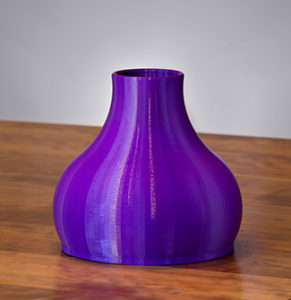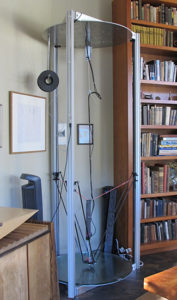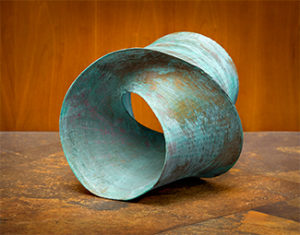First, there is no question 3D printed sculptures are art. Fine art. Look at my work or that of others working in this field and you will quickly see how the form and design have aesthetic purpose, beauty and a unique perspective.
That doesn’t mean everything created using this tool is art – 3D printing is being used to create many other exciting things including machine parts, medical equipment, cars, even body parts – but it does mean 3D printing can and is being used to create art. Just like a paintbrush or a potter’s wheel, 3D printing is simply another tool used to create art. It takes an artist with an interest in the technology to use the tool effectively.
In this article …
Why I Use 3D Printing
Sculpture to Jewelry
Using the Equipment
My Printers
The Challenge
WHY I USE 3D PRINTING
 Curved Vessel, a 3D printed contemporary art sculpture by Kevin Caron|Prior to even knowing about 3D printing – which has been in use for two decades – I taught myself Computer Aided Design (CAD) to use as another tool to help me create both commissions and sculptures that feed my own soul. I have used a number of CAD programs over the years, including Punch home design, SketchUp, Alibre Design and GeoMagic. I am now learning Rhino, a more advanced program.
Curved Vessel, a 3D printed contemporary art sculpture by Kevin Caron|Prior to even knowing about 3D printing – which has been in use for two decades – I taught myself Computer Aided Design (CAD) to use as another tool to help me create both commissions and sculptures that feed my own soul. I have used a number of CAD programs over the years, including Punch home design, SketchUp, Alibre Design and GeoMagic. I am now learning Rhino, a more advanced program.
CAD software helps me put onto “paper” what I see in my mind and opens my awareness to new possibilities. I am able to let my mind run free and think purely in form; how I eventually physically manifest each piece – in steel, aluminum, or as a 3D-printed sculpture – is secondary. Fueled by a sense of wonder and curiosity, something inside me takes over my hands and fingers and brain. I wander and play with the lines, shapes, curves, twist and turns until a sculpture feels like it has its own unique spirit.
The more I work with CAD, the more I learn about form and am able to push my own artistic boundaries. It also has expanded my abilities in metal fabrication, inspiring me to learn about new methods and tools to make the shapes I’ve created on the screen come to life. This journey has encouraged me to become a better fabricator as well as a better artist.
Once I have created a sculpture, CAD allows me to change its height, color and proportions. I can tweak the form all I want while seeing it in three dimensions. I can rotate it and see the top and the bottom at will. For commissions, I often place these images into photographs of a proposed location.
3D printing has also enabled me to physically manifest my designs as maquettes (small models) for presentations and to help me create sculptures because I can now literally see how they fit together. I also create original sculptures such as Simple Planes With Aquamarine Stripe, Holy Cannoli, Vessel and Limoncello.
SCULPTURE TO JEWELRY
 Campfire earrings, created by Kevin Caron using 3D printing|3D printing has also allowed me to create a jewelry line. I have always loved jewelry: its proportion; its proximity and relationship with the body; its color, the shadows it casts; and, in the case of metals, its reflection. 3D printing has opened the door for me to manifest these small, delicate sculptures as wearable art.
Campfire earrings, created by Kevin Caron using 3D printing|3D printing has also allowed me to create a jewelry line. I have always loved jewelry: its proportion; its proximity and relationship with the body; its color, the shadows it casts; and, in the case of metals, its reflection. 3D printing has opened the door for me to manifest these small, delicate sculptures as wearable art.
Some of my jewelry designs actually originated as sculptures. I initially designed BackFlip for a 12,000 square foot residence on the side of Camelback Mountain in Phoenix, where this 7-foot-tall sculpture still stands. I knew the design would make beautiful earrings.
Mobius also began as a kinetic sculpture that is in Paradise Valley, Arizona.
Torus is a version of a design I’ve created as a full-size sculpture in three different versions thus far, Torrent, Crimson Singularity and Wherever You Go, There You Are, which is nine feet tall.
Campfire (right) and Sand Dollar have yet to be created as anything but earrings, but I would like someday to fabricate each of these in a monumental size.
USING THE EQUIPMENT
Printing my own 3D printed creations isin keeping with how I fashion my metal works.
|https://kevincaron.com/page_ Cerberus 3D Gigante 3D printer – Kevin Caron|Some artists use 3D printing software to design their work but do not print the sculptures themselves. In fact, a 3D service bureau prints my jewelry because my 3D printers do not have the capability to print items as small and detailed as jewelry.
Cerberus 3D Gigante 3D printer – Kevin Caron|Some artists use 3D printing software to design their work but do not print the sculptures themselves. In fact, a 3D service bureau prints my jewelry because my 3D printers do not have the capability to print items as small and detailed as jewelry.
I print nearly all of my sculptures, however, using one of three 3D printers I own. This makes perfect sense, because the tools I have used throughout my six years in the Navy, as a foreign-car mechanic and now as an artist, are part of my practice. My forms and their proportions often reflect those of the tools, albeit often with a twist on or elevation from the original inspiration.
MY PRINTERS
I currently have three 3D printers. My first printer was a 3D Systems CubeX printer, which can print something the size of a regulation basketball. It also prints in 3 colors. I jumped on the 3D printing juggernaut when 3D Systems, which also owns GeoMagic, the CAD software in which I’ve created many of my designs, offered a 3D printer, I was quick to order one. It took about nine months to get it, and I immediately began using it to print in ABS filament. You can see it in operation in a series of videos I created about using a 3D printer.
I also own two Cerberus 3D printers, a 250 desktop model, and a Gigante (right). The Gigante was developed by Cerberus 3D’s Steve Graber when, after seeing him demonstrate the 250, I asked if he could build a larger model. The result is the Gigante, which is 8 feet tall and can print pieces more than 4 feet tall.
[back to index]
THE CHALLENGE
 While working in 3D printing with my own machines is truly exciting, it is also amazingly challenging. Not only is this “bleeding edge” territory, it is early “bleeding edge.” You have to have an analytical streak, a tinkerers curiosity and toolbox, and the patience of a saint. Fortunately, I have these attributes – at least that’s what I’m told about the patience.
While working in 3D printing with my own machines is truly exciting, it is also amazingly challenging. Not only is this “bleeding edge” territory, it is early “bleeding edge.” You have to have an analytical streak, a tinkerers curiosity and toolbox, and the patience of a saint. Fortunately, I have these attributes – at least that’s what I’m told about the patience.
Thus far, I have never had two prints come out exactly the same. They are affected by temperature, run speed, filament and probably dumb luck. These variations contribute to the serendipity of creation.
Someday, and likely someday very soon, 3D printers will be an appliance like many others most of us have in our homes. Prints will be more likely to print flawlessly than not. We won’t think twice about downloading a design, pushing the button and walking away.
That isn’t true quite yet, and the Gigante, with its long and large prints, is certainly beyond what most people will ever own for personal or home office/studio use, much less be interested in.
For me, though, these machines are part of what makes my work fulfilling, and I will continue to let them challenge me as part of my toolkit for making art that moves people.
To learn more about my adventures with 3D printing, please visit my blog “A Sculptor’s Take on 3D Printing.”
